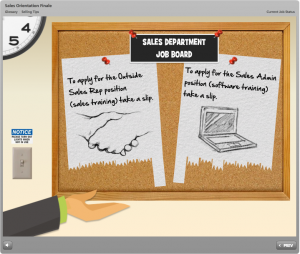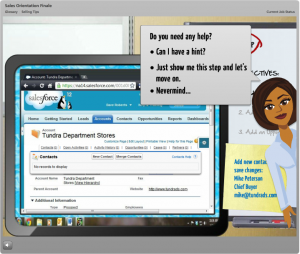
Even though it’s years old at this point, we keep getting inquiries about this course that won Gold in an Articulate Guru Competition. That’s why today, we’re outlining what made it so successful.
A little background: Sales orientation training is notoriously difficult because it requires the user to be highly engaged with the material. So when it came time to develop an eLearning course of our own on the subject, we knew we needed to get creative and add some powerful elements that would keep participants interested from start to finish.
We also wanted to showcase Storyline’s native abilities, so we designed it using only functionality and assets from the tool itself (except for a few stock background images.) For the purposes of this course, we wanted to show what we could do using nothing but Storyline, its built-in characters, and its included functionality.
Here’s how we did it.
Realistic Activities
Using Articulate Storyline’s drag and drop quizzing feature, we were able to create activities that mimicked real-life actions. For example, at the beginning of the course, the user has to pull a tab of paper off of a job board to choose their job.

As we explained to the Guru judges, “Wrapping training in real-world scenarios lets you explore on your own and possibly fail. We wanted to force learners to make actual cognitive connections instead of simply following the leader. This challenge gives you an opportunity to make a real connection to the material.”
Branched Scenarios that Stick
Variables make the course feel more realistic by tracking the choices made by the user throughout the course. That means that even if you take the course more than once, you’re going to get different outcomes with each different choice.
These choices then impact the characters within the course. For example, the sales rep learners have to respond to a chief buyer for a department store who gets happier or angrier depending on the learner’s performance. Performance in the sales call determines if you get a job offer or not. And for fun, there are two hidden ways to get yourself immediately “fired.”
By using these types of branched scenarios, learners benefit from an experience that feels like real life.
Software Simulation
While tools like Salesforce are known to be tricky to get the hang of, our sales simulation helped learners get hands-on practice with activities like entering contacts, events, and opportunities into the software. Along the way, participants can get hints and help that encourage them to keep trying.

Then, at the end, the scoring system we implemented tells the user exactly which steps they got right, wrong, and where they needed hints. We created a custom scoring system that deducted points if the learner needed hints. The customized feedback knew everything about how the learner performed, so the course would not only tell them if they passed or failed, but the course could even recognize if they would have passed if they had used fewer hints. It was all the detail in the experience that made it seem more real and less like a typical eLearning course.
Situational Training
Training for sales calls is difficult because there are so many different possible outcomes. However, we gave learners the chance to get experience with nine different outcomes based on the call’s overall “temperature.” All of the feedback was provided within the context of the call itself. No “correct” or “incorrect” feedback here. We built feedback with all the gray area that real life provides. Life doesn’t pause to tell you “Correct, great job!” Neither does our course. Learners must interpret the reaction of the buyer they’re selling to and choose from situationally relevant responses based on his reactions.
Not only does this type of situational training prep sales trainees for real scenarios that can happen on the job, but it also shows them the proper way to handle different calls before they interact with real clients.
Performance Reviews
We wanted this course to be more than a scoring sheet for how many answers were wrong or right—it needed to be reflective and insightful for the learner.
We again opted for a more lifelike tie-in, which came in the form of performance reviews for the participant’s character. When the learner could look from the outside in, they gained perspective on themselves as a part of the company as a whole.
Judges Review
Here’s what the Articulate Guru judges had to say about the course: “We loved that Tim and his team showcased so many of Storyline’s key features. They relied on slide layers, triggers, and states to develop personalized feedback and compelling interactivity, even within the software simulation. They used form-based and free form quizzing to assess learners and, in one case, branch learners between jobs. They powered nuanced scoring and realistic course branching with variables. And they tapped Storyline’s characters to connect learners with the material.”
When you use Articulate Storyline’s powerful tools, you can create an eLearning experience that’s truly exceptional.
Want us to develop your next course? Get in touch.
